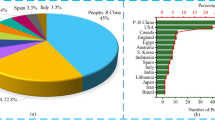Abstract
The advancement of transportation machinery has played a crucial role in driving global economic and societal growth. However, this progress has also given rise to challenges, such as the depletion of chemical resources and the escalating impact of climate change. As a result, automobile companies are now prioritizing energy efficiency and transitioning towards eco-friendly vehicles. In response to this demand, various efforts have been made to harvest energy and improve the efficiency of eco-friendly vehicles, with energy-harvesting dampers emerging as a promising solution. This study focuses on the optimization of the shape and design of a rotary power generation system integrated within an energy harvesting system. The primary objective of the rotary power generation system is to convert mechanical motion into electrical energy, thereby enhancing the overall efficiency and sustainability of eco-friendly vehicles. By considering the specific characteristics of SAE 30 W working oil within the damper, the optimal blade shape and generator can be determined to maximize the power generation capabilities of the system.



















Similar content being viewed by others
Abbreviations
- A:
-
Area, m2
- T:
-
Torque, Nm
- ω:
-
Angular velocity, rad/s
- Re:
-
Reynolds number
- U:
-
Fluid velocity, m/s
- L:
-
Characteristic length, m
- v:
-
Kinematic viscosity, m2/s
- μ:
-
Dynamic viscosity, Pa·s
- ρ:
-
Fluid density, kg/m3
- Pm:
-
Rotational power, W
- Pe:
-
Electric power
References
Avadhany, S., Abel, P., Tarasov, V., Anderson, Z. (2000). Regenerative shock absorber, US Patent 0260935.
Bhuyan, D., & Kumar, K. (2017). 3D CAD modelling and computational fluid analysis of piston valve of twin tube shock absorbers. Materials Today, Proceedings, 4(8), 7420–7425.
Cho S. J., Kim, J. H. (2016). The design of linear electromagnetic generator system for vibration energy harvesting technology for vehicle suspension. KASE Annual Conference Proceedings, pp. 267–267.
Fiori, C., Ahn, K., & Rakha, A. (2016). Power-based electric vehicle energy consumption model: Model development and validation. Energy, 168, 257–268.
International Energy Agency (IEA). (2020). Global EV Outlook 2020: Entering the decade of electric drive?, https://www.iea.org/reports/global-ev-outlook-2020. Accessed 11 Oct 2023
International Organization of Motor Vehicle Manufactures (OICA). (2020). Employment in the automotive industry by region, 2010–2020, http://www.oica.net/wp-content/uploads/sites/2/ocia-employment-automotive-industry-2010-2020.pdf
Kim, J. H., Kim, J. H. (2018). Analysis of relative displacement of electromagnetic suspension using CARSIM and Simulink. KAIS, Annual Conference Proceedings, pp.82–88.
Kim, S. M., Park, C. H., & Kim, J. H. (2020). Design optimization of screw blade for shock-absorber harvesting system. KSAE, 28(11), 809–815.
Kim, T. D., Kim. J. H. (2019). Verification of generation of energy harvesting suspension by blades. KSNVE, Annual Conference Proceedings, pp. 115–115.
Lee, K. H., Park, G. J. (1996). Discrete design in constrained optimization using orthogonal arrays. KSME, Annual Conference Proceedings, pp. 980–985.
Msuya, R. A., Kainkwa, R. R. M., & Mgwatu, M. I. (2017). Design of a small scale wind generator for low wind speed areas. Tanzania Journal of Science, 43, 138.
Pan, H., Qi, L., Zhang, Z., & Yan, J. (2021). Kinetic energy harvesting technologies for applications in land transportation: A comprehensive review. Energy, 286, 0306–2619.
Ruan, J., Walker, P., & Zhang, N. (2016). A comparative study energy consumption and costs of battery electric vehicle transmissions. Energy, 165, 119–134.
UNCTAD. (2019). World trade statistical review, https://unctad.org/system/files/offical-document/wir2019_en.pdf
Xie, X. D., & Wang, Q. (2015). Energy harvesting from a vehicle suspension system. Energy, 86, 385–392.
Zhang, Y., Chen, H., Guo, K., Zhang, X., & Eben Lib, S. (2015). Electro-hydraulic damper for energy harvesting suspension: Modeling, prototyping and experimental validation. Energy, 86, 385–392.
Zuo, L., Scully, B., Shestani, J., & Zhou, Y. (2010). Design and characterization of an electromagnetic energy harvester for vehicle suspensions. Smart Materials and Structures. https://doi.org/10.1088/0964-1726/19/4/045003
Zuo, L., Zhang, P. S., & Vib, J. (2013). Energy harvesting, ride comfort, and road handling of regenerative vehicle suspensions. ASME, 135, 011002. https://doi.org/10.1115/1.4007562
Acknowledgements
This research was supported by the National Research Foundation of Korea (NRF) grantfunded by the Republic of Korea government (MSIT) (No. 2022R1A2C1005357) and a Yeungnam University Research Grant in 2023.
Author information
Authors and Affiliations
Corresponding author
Additional information
Publisher's Note
Springer Nature remains neutral with regard to jurisdictional claims in published maps and institutional affiliations.
Rights and permissions
Springer Nature or its licensor (e.g. a society or other partner) holds exclusive rights to this article under a publishing agreement with the author(s) or other rightsholder(s); author self-archiving of the accepted manuscript version of this article is solely governed by the terms of such publishing agreement and applicable law.
About this article
Cite this article
Kim, H.J., Kang, S.M., Kim, S.M. et al. Meta-Model Based Blade Optimization Design Considering the Fluid Characteristics of Vehicle Energy Harvesting. Int.J Automot. Technol. (2024). https://doi.org/10.1007/s12239-024-00049-z
Received:
Revised:
Accepted:
Published:
DOI: https://doi.org/10.1007/s12239-024-00049-z




